Fresh horseradish. Just the thought of it makes my eyes water with glee. If you want to know how to make the best prepared horseradish from fresh roots, you're in the right place.
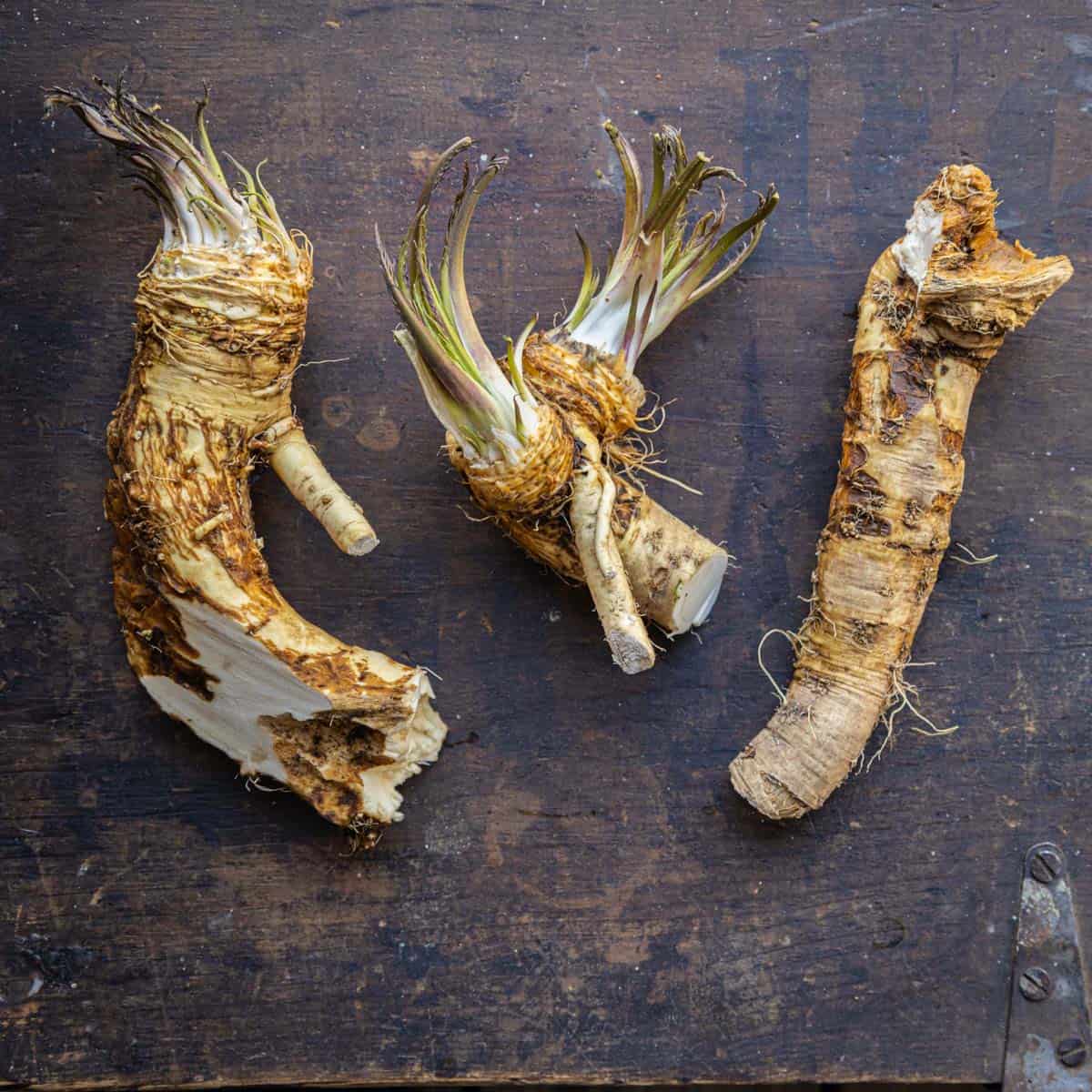
Horseradish is an ancient condiment, and It's kept a good popularity compared to other root crops like skirret and parsley root.
It's popularity has to be due at least partly to the fact that the root can be preserved and still retain some of it's character, since you can go into any grocery store, anywhere in America and find the small jars of commercially prepared horseradish.
Unfortunately, commercially prepared horseradish is typically weak, often overly sweet and disguised with additives like mustard oil to make up for it's worthlessness. It's also brown and oxidized, which I can't stand.
Sure, some of the store bought stuff will have a little kick, but there's no comparison to the same thing made with the freshly grated root. Absolutely. No. Comparison.
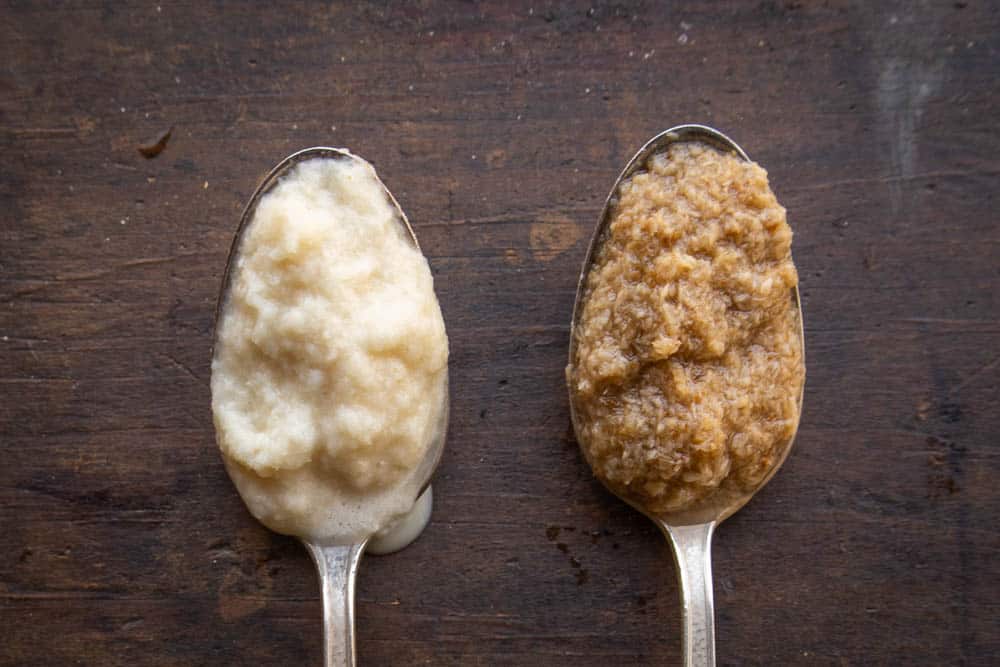
The fresh stuff can be a little tricky though. I didn't work with fresh horseradish until I worked for Lenny Russo at Heartland, where only local horseradish showed up at specific times of the year: Spring, and Fall, for the most part.
We never thought much about the timeline, but the timeline is an important part of harvesting—something I would get acquainted with at my first restaurant where we cooked 20-50 lb of smoked prime ribs every night. Just like at Heartland, I only bought my horseradish fresh, but, unlike Heartland, I bought it all year long, since my smoked prime rib never came off the menu.
"Only dig horseradish in months that have an R in them" or is it "Only dig horseradish in months that end in R?" Possibly both.
One day while showing someone how to make prepared horseradish from scratch, I got irritated when the finished product didn't come out right.
I demonstrated how to grind the roots just like we did the fresh horseradish we'd ordered a couple months before, but this time, the roots had no power, no potency, the only thing that remained was their bitterness.
Calling it white cardboard shavings would've been appropriate. This was roughly in June, the previous order of horseradish having probably come in the Spring. Therein lies the secret.
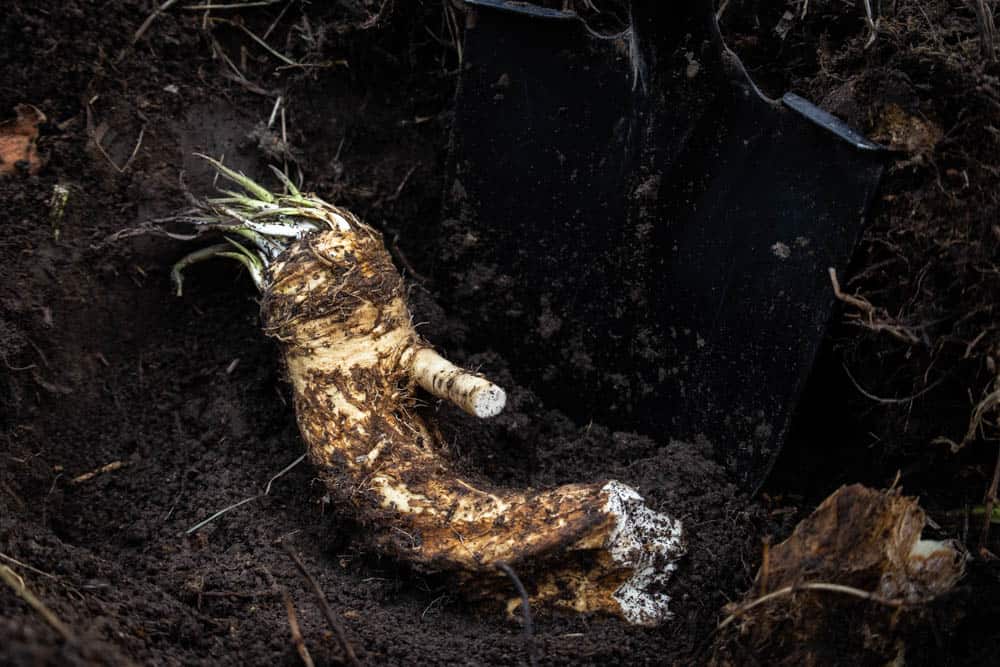
When to dig
The old saying about horseradish is that you only dig it in months that have an R in it, basically from September to April. Some people would say that it should be "only dig in months that end in R". Depending on where you live, and how cold it is, it could be either.
I'll also say that I prefer to dig it when it's been cold outside, or after we've had a few frosts. Another way to go about it might be to avoid digging it when it has developing or mature leaves.
The more I learn about plants, I can only assume that the lack of fire in horseradish during the warm months has to due with where the plant is putting it's energy.
During the growing season, the roots are putting energy into making its enormous leaves (also good) so they can photosynthesize, and from there, possibly produce flowers reproduce, etc. I say possibly produce flowers there since the two horseradish colonies I know of have never flowered, and it seems to be another eccentricity of the plant.
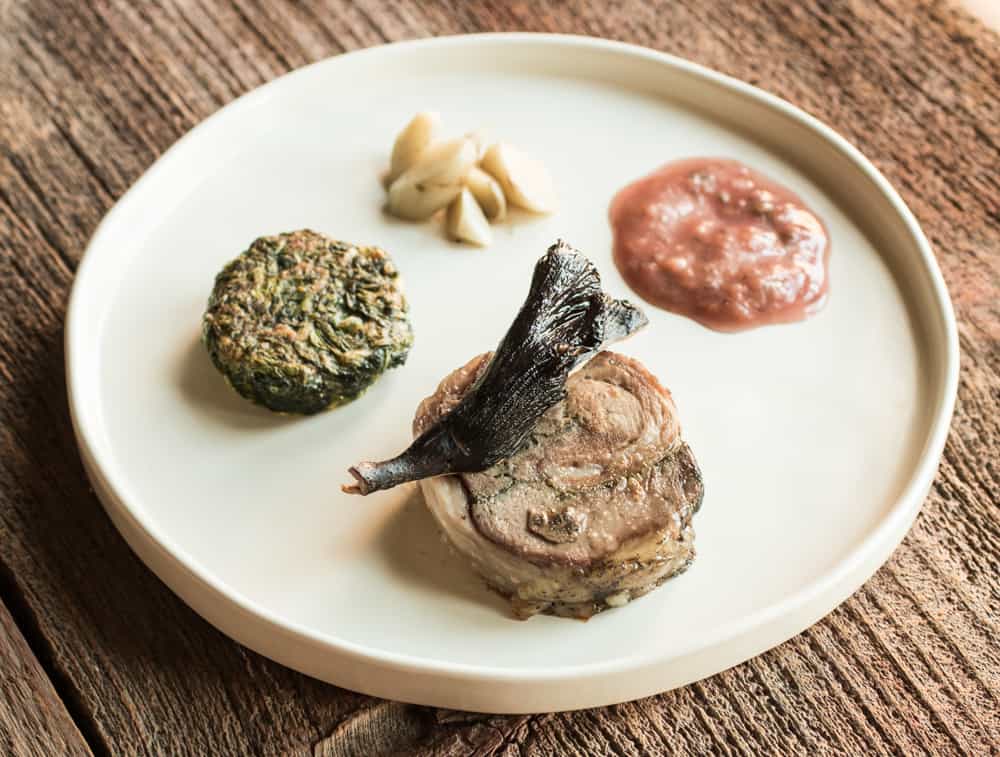
Wild horseradish
Foraging for horseradish is a thing, and it's been a close kept secret of sushi chefs in America for a while. They seem to be the only ones that go searching for the plant besides weirdos like me.
I see wild horseradish rarely in Minnesota and Wisconsin, but I do have one feral patch I like to visit in the summer for leaves.
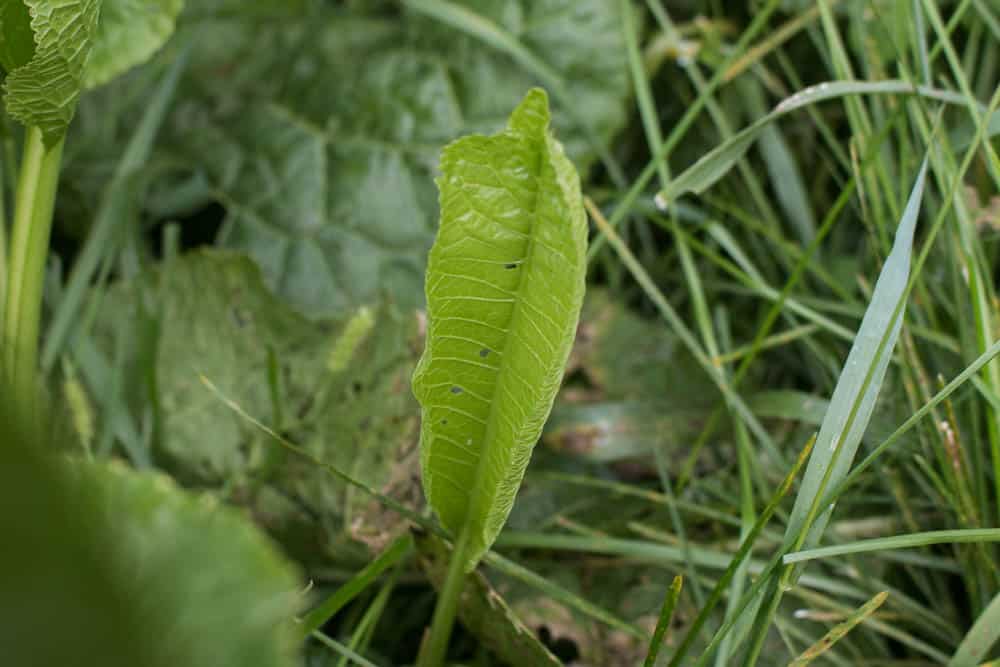
I've also seen it planted in community gardens and parks. If you find some in the wild, you might consider digging up a root or two to plant in a convenient place you can get too.
Some people will call it weedy, and horseradish can be stubborn, but it's not that aggressive compared to other things—you can easily keep it in check with a mower.
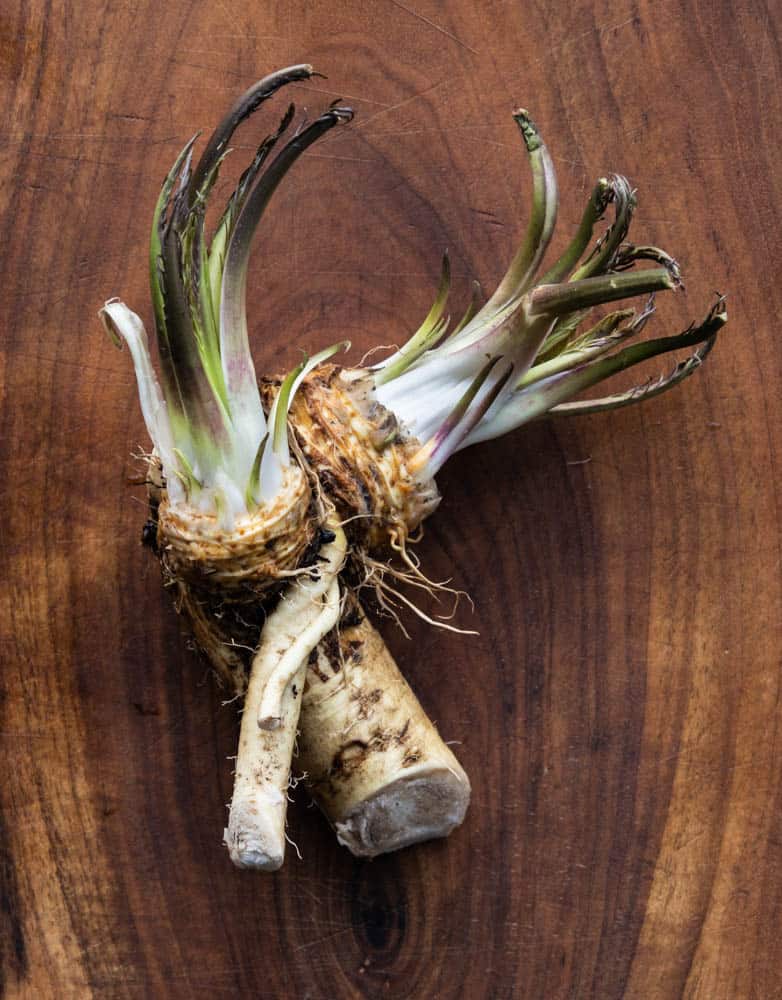
Horseradish Leaves and Shoots
Oh yes, you can eat horseradish leaves. But, unless you've seen the plant in person, you may have never thought about consuming them.
The only catch is that you're not going to be wilting them like spinach per se. Horseradish leaves have a bitter, strong horseradish flavor, so when I cook with them, if they'll be used as a wilted green, I cook them in a blend with other mild greens like lambsquarters, watercress, etc.
Unlike other edible greens, horseradish leaves grow to be humongous, so they can be used for wrapping food. Here's a few of my favorite things to do with them.
- Blanched and shocked, (remove the stem too) long, mature horseradish leaves are great used to wrap fish to put on the grill, or line a pan that you'll fill with meatloaf, or a terrine.
- Fresh, you can use them in a salad if you remove the stem, cut them into small pieces or chiffonade the leaves into fine shreds. From there, you can use them, say combined 50-50 with other greens and use as you would a salad of bitter greens like radicchio or dandelions.
- A small amount can be a nice garnish for a rich piece of meat or fish, but I still like to mix them 50-50 with other greens, even after blanching. '
- The small tender shoots are one of the best parts of the plant—I may add them to salads and other things whole.
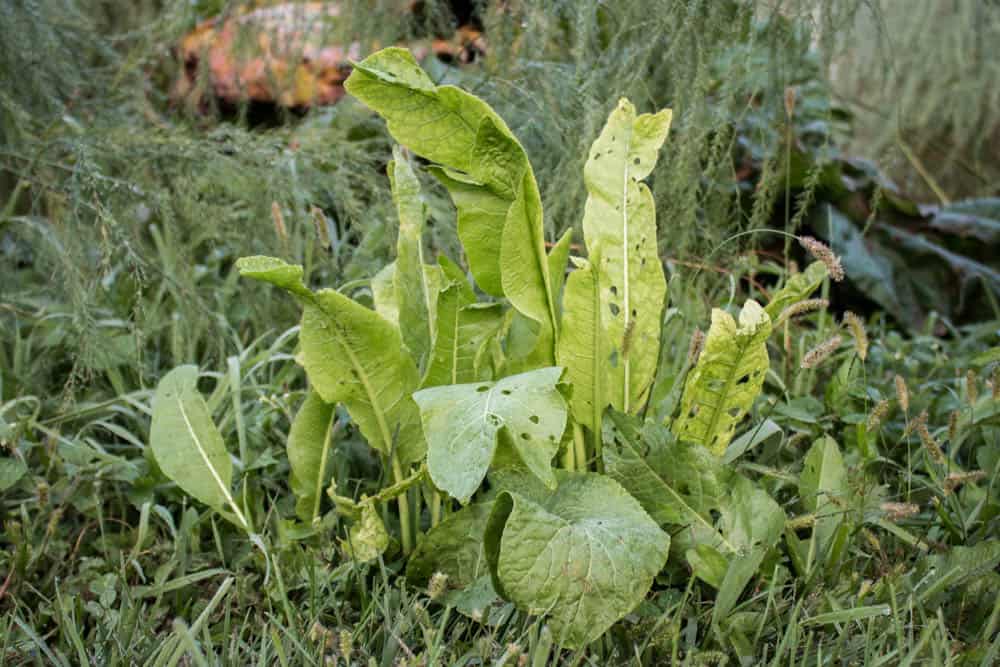
How to use it
Prepared Horseradish
Do you like hot fire, weeping and agony? I do. Good horseradish should be strong enough to offend people in it's raw form. This is the real stuff, what store-bought horseradish in a jar could only dream of becoming, and the perfect addition to your cocktail sauce and horseradish sauce for prime ribs.
Some people grate their horseradish, and that's, ok I might grate it sometimes depending on how much texture I want, since a coarse grater can give nice pops of fire, but, most of the time, I just make prepared horseradish from scratch.
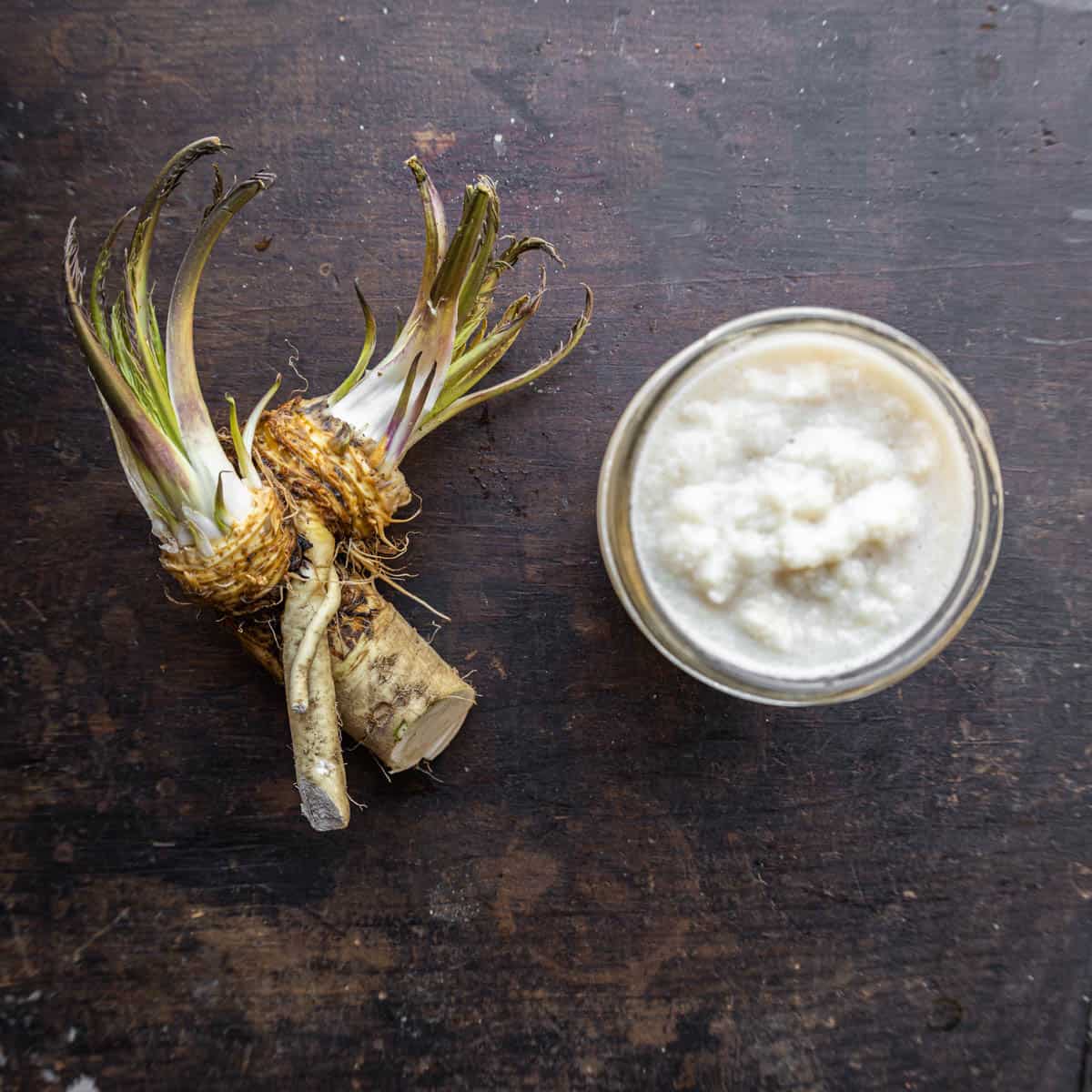
To make prepared horseradish from scratch, all you need is a little vinegar, water and a pinch of salt and sugar.
The good part about doing it in the blender, is that you don't have to grate the horseradish by hand using a box grater, which involves all the fumes creeping up to your face. Do be careful taking the cap off the blender though—the fumes are weapons grade.
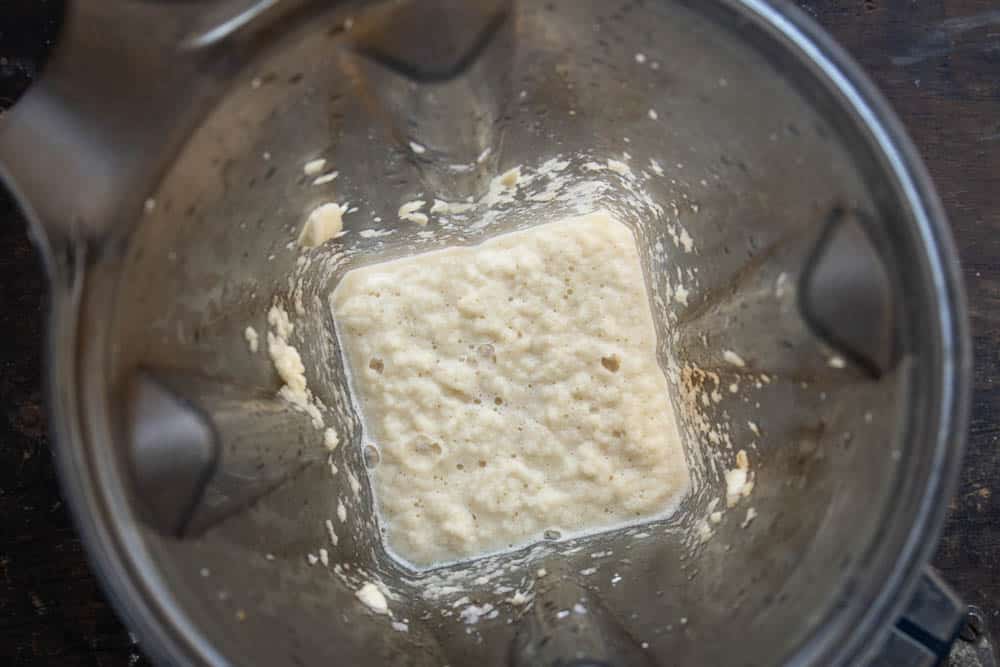
Grating the roots straight-up
Prepared horseradish is only one thing the roots can be. In Scandinavia and other places, the roots are commonly grated fresh, directly onto food. It's a great way to use the roots if you have some fresh ones sitting in the fridge.
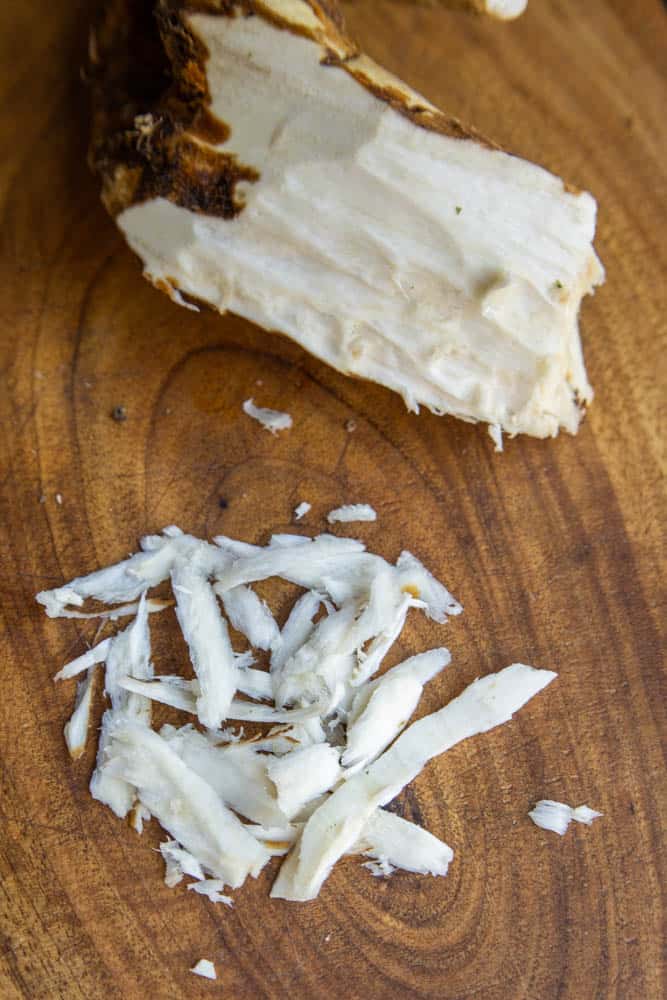
Fermenting the roots?
Just because you can ferment something, doesn't always mean you should. Some chefs put this on menus and claim it's something special—It isn't. I've done it a few times (salting and fermenting for 1-2 weeks) and the flavor gets lost, tasting just like the lackluster horseradish I bought in June back at the restaurant.
I don't know if it's the subtle ambient warmth from the fermentation process that does it, but it could be, since horseradish doesn't like to be cooked. Either way, preserving the roots in vinegar as for prepared horseradish, or grating and mixing with cream and freezing are both good ways to preserve the flavor. I also don't recommend fermenting the leaves.
How to Make Prepared Horseradish
Equipment
- High speed blender like a vitamix, food processor or a fine grater like a microplane
Ingredients
- 4 oz horseradish root
- 4 oz water
- 4 oz white vinegar or your favorite vinegar
- ½ teaspoon salt
- 1 teaspoon sugar
Instructions
- Peel the horseradish and set aside 4 oz. Mix the water and vinegar.
- Cut the horseradish roughly into ½ inch pieces, then put in a blender with the salt and sugar.
- Alternately, grind the horseradish in a food processor-you may need to add a little additional water and vinegar, in equal proportions.
- Pulse and then puree the mixture until smooth, slowly drizzling in the water and vinegar, then scrape into a jar and refrigerate. You may not need all of the water and vinegar depending on the strength of your blender or food processor.
- Prepared horseradish will last for a long time. Drain some of the liquid off before using to avoid making sauces too runny.

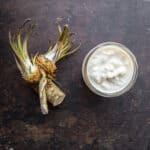
Vanessa
Hi Alan,
Thank you very much for your amazing recipe!
Question for you, what can I do to make the prepared Horseradish milder?
Not too hot for my kids..
Alan Bergo
Hi Vanessa. You have a few options. The first one is to use horseradish that's available in a store during the summer, as it will be naturally milder. The second method is just to make horseradish cream with the horseradish, which will allow you to add it to your taste.
Danica
Hi Vanessa,
Add more water and sugar and less vinegar. You can also tone it down mixing it with source am or mayonnaise or Miracle Whip (which is more sweeter).
My parents were Slovenijan and my vivid memories of them grating horseradish roots in January was the only time when both were crying at the same time. I loved eating it raw, the prickly sensation on my tongue then, the tears that followed.
After grating, my father finely chopped it up then used a meat tenderizer, on bits, to pulverize it and blended in to the sour cream.
Julia
This is great basic horseradish preparation. If you want to play around with it and have different flavor profiles, you can add several heirloom tomatoes for a tomato horseradish sauce or a small beet - a classing Ukrainian horseradish sauce (my granny used picked tomato juice instead of vinegar for an extra special flavor). The color of the beet sauce is stunning and the flavor is unique.
Alan Bergo
Absolutely, thanks for commenting Julia.
Jillian
Excited to try this recipe! I’ve also been thinking about fermenting a small batch in raw honey…I was curious if anyone has tried that?
Alan Bergo
Fermenting horseradish will remove its heat. You’ll get some aroma but that’s it.
Travis
I like to use the large wide leaves to help hold down ferments. the thick rib wedges into the sides of the jar nicely to help keep things below the brine. It's also rumored to help keep things crunchy. They are usually a top to a layer of wild grape leaves.
Alan Bergo
A great tip and a good way to use any that have bug damage too. I can't wait to use them for leaf rolls next year.
Dave Budgar
Hi Alan. I'm wondering if apple cider vinegar is ever a good option when making prepared horseradish. Thanks for your thoughts.
Alan Bergo
Yes that’ll work fine.
Dave Budgar
Thank you!
Joan
Is it better to use large thick roots or small tender ones?
Alan Bergo
I prefer thick roots as they’re easier to work with and clean.
Jacob
I have a question regarding grating horseradish and adding the vinegar afterward. Grating a 2 oz. piece takes me more than 10 minutes. Most people are blending theirs and they say to wait no longer than 2-3 minutes after it's done before adding the vinegar to get the hottest horseradish or it will be bitter. In my case, since I'm over the 2-3 minute waiting mark, would the horseradish still maintain it's hot flavor if I were to grate it over a bowl of vinegar or should I not grate it and blend it instead so I'm within that waiting time?
Alan Bergo
You can do either. Waiting a little time won't make it bitter, I don't know where that comes from. The reason you want to combine it with vinegar quickly is to prevent it from turning brown.
Pam
I put mine in a foot processor on high speed with a bit of water and I also used a few ice cubes to help it process... I read about that somewhere on line and I was concerned about the water and ice cubes if it would cause it to have too much liquid..process longer To get it finer and stop and scrape down the inside of the bowl...much , much faster than hand grating... it works for me ! And the aroma is very intense, watery eyes sneezing, etc! Yum
Alan Bergo
Thanks for sharing Pam. Yes there's lots of ways to do it. I typically use a vitamix blender but a food processor works great.
Marla
Hi, Alan! With the awesome assistance of this post, I just finished my first batch of made-from-scratch prepared horseradish. I was only able to procure horseradish in 1-lb roots, so I have a LOT of it. I'm planning to store in mason jars and have these questions:
1) Does all of the horseradish in the jar need to be covered by fluid? In other words, do I need to add more vinegar/water to the storage jar after processing to protect the horseradish from degradation?
2) Can I freeze prepared horseradish?
Alan Bergo
Thanks for commenting Maria. You can just top the jar off with a little extra vinegar-that's what we always did. It's fine to freeze it too, but I usually just keep it in the fridge.
Irene J.
HELP,!!!!! We just made fresh horseradish. when we were grinding it it was ver strong, let the air at it for 20 minutes to enhance the hotness and it still wasn’t hot to taste. Here’s how we handled it; We cut it the day before and kept it in water. Washed in my wash machine which worked great for cleaning. Peeled and cut up also put in water to keep moist. Drained, used a commercial grinder. Ground it 3 times every time used a smaller cutting disk. Yes it was very strong in the air! But to taste right out of grinding it was very bland. What did we do wrong? I never even put Any vinegar in the sauce as not to cut any hotness that may be there. Maybe we shouldn’t have cut the day before….or put it to soak in water overnight, or keep it in water after peeling, or using the wash machine for cleaning? Help. We don’t want to go through all this work again for not very tasty sauce!!!
Alan Bergo
So, my thoughts are that it may not be cold enough where you are. Horseradish dug when it has not been exposed to cold can be extremely mild. This often happens when it is purchased commercially as it’s harvested year round.
Irene J
Thanks for getting back so fast! I live in Northern Wi. We have had 3 frosts. Where the horse R is frost had touched and shriveled the leaf. We dug in a different area of this patch just because the roots were bigger. Is that our problem too? Roots to big? Dang I just want to figure this out.since we dug we have had 2 hard freezes. Do you think I used to much soaking in water , banging and more water in the wash machine a long with not quite ready by a hard frost???
etm567
I read two conflicting directions for making horseradish sauce. One said the sooner you add the vinegar, the hotter the sauce will be. The other -- Chef John -- said he had heard many years ago that you should wait two minutes after grating the horseradish before you add the vinegar. ??? Opposite instructions. I shall try both ways when we can buy some roots in November. Next year we will plant some. And, btw, freeze that prepared horseradish. And/or can it the way these two ladies said to -- pack it into jars, do not tighten lids yet, leave on counter two to three days, then tighten and put into cold storage. But once you open a jar, unless you will use it pretty quickly -- within a month -- best freeze it.
etm567
I made an error. Not "sauce," "Prepared horseradish" is what I should have said.
Alan Bergo
I've made gobs and gobs of this and I was taught to just blend the horseradish with vinegar in a blender. We would make gallons at a time to hold in the fridge for restaurant work. It was always fantastic, provided the horseradish had a good flavor to begin with. I wouldn't bother with those picky details others mentioned-they sound like misguided folk wisdom to me, personally.
Wendall S Lawrence
What is a good shredder/blender to process the roots? I like my horseradish super fine. I don't want to sacrifice my knuckles on a hand grater. Bought the fine attachment for my KitchenAide but it just clogs up and leaves a lot of big chunks wrapped around the attachment. Tried a food processor but it is too course for my liking. Any suggestions?
Alan Bergo
Use the grating attachment of a food processor. To make it really, really fine, puree horseradish roots cut into pieces in a blender with vinegar to cover, which will give you pulp similar to what you find in a store.
Keith Etzel
Allen,
Can you dig horseradish roots one day, clean them, and grind them two days later. I would put them in the refrigerator till ready to grind.
Thank you
Alan Bergo
Hey Keith. Absolutely. Roots are durable things. Store them wrapped in a moist towel in the fridge and they will last for weeks. If they get soft or limp just soak them in ice water for a few hours and they'll come right back.
Maureen
My horseradish roots were dug up in October 2023 here in Muskoka Ontario Canada 🇨🇦
I peeled them and left them in a paper bag over the winter.
I just re-hydrated them in water this morning and made your recipe in my Vitamix blender.
I wasn't sure if I'd left them too long but they turned out great!
Thanks for the recipe!
Alan Bergo
Hey Maureen, great. Glad it worked for you. The roots can be sturdy little things, that's for sure.
Mary
About a mile from my home there was a huge horseradish farm at the turn of the century, like 100+ acres. It has probably been 60-70 years since it was farmed, but you can still find it growing on the edges of those old fields, even after the DNR dredge those fields and turned them into wetlands. I find it to be a pretty tough plant.
zunehmendwild
Hi Alan, thanks for the inspirations of what to do with harvested horse radish. One part of the plant I also like to use is the flowers. Dipped into buckwheat dough and fried (like tempura) they are quite nice also.
Kind regards
Peggy
Alan Bergo
Yes a few people have mentioned that. None of my plants have ever flowered, weird enough. I wish I could try them!
Jo Hammond
That sounds fantastic. Always looking for new ingredients to add to the mix in tempura.
Marnie
I have two patches of horseradish that have been growing in the same place for a very long time. How can I nourish them and which roots do I leave and which do I dig, younger smaller/older larger and tougher. How quickly does it replenish itself after being dug up? Basic tending needs etc ...
Thanks!
Alan Bergo
I'm speculating here a bit from my own experience, which only really involves harvesting feral plants occasionally. I would havest older roots, and if you want them to spread I would make sure each colony is a few feet apart, spreading roots farther apart to give them room as they gradually spread. My patch is so plentiful I've never worried about overharvesting. Horseradish is a sturdy, stubborn plant, but it won't get aggressive and weedy like other things. I like to think of them more like a fixture in the landscape, like fruit bush or shrub.
Ann Yates
I’ve grown horseradish for 20 years. The old plants are very difficult to harvest because their root system becomes massive and the roots near the center are woody and tasteless. We end up with a hole 3 feet wide and two feet deep for younger roots. I’m switching to planting crowns to harvest the next year or two. I’ll probably end up with a horseradish plantation. As for the fumes, I have a theory. My theory is that, for those of you with the moxy to tackle the task, you probably will have eyes and sinuses that age better, no cataracts, etc. just a theory about nature
Judy
I think it’s important to mention that one should store the freshly prepared horseradish in a glass jar with a plastic lid. I have seen the fumes from a jar of fresh horseradish EAT THROUGH a metal lid. Since I don’t have a Vitamix blender, I grate the roots using the shredding blade on my Cuisinart, then process them with vinegar in my Osterizer. I planted horseradish in one far corner of my vegetable garden, and it comes up in all sorts of places nearby. It is easy to harvest those stray plants when preparing to plant the vegetables each spring. It’s a friendly invasive.
Alan Bergo
If the fresh horseradish didn't contain vinegar it would be fascinating if it reacted with the jar like that, was it just raw, unseasoned horseradish?
Judy krohn
I think you are right—the combination of vinegar & horseradish is probably the culprit. That horseradish is pretty volatile alone, though.
Jacqui
My Dad bought an army surplus gas mask for his mother, my grandmother, for her horseradish-grating activity. And she used it. This was before the age of a blender in every kitchen...
David Sparkman
While I love horseradish, a strong wasabi is my favorite. Can you tell me the difference?
Alan Bergo
Hmm. So, as far as your question "can you tell me the difference?" I need a little more clarification to answer it directly. What I can tell you is that they're similar: both are Brassicaceous plants related to all the mustards, broccoli, etc. Wasabi is similar looking, but it's pure green in color. I haven't worked with fresh wasabi, but I do know it's reputedly very difficult to grow. Horseradish is a snap. I like them both.
Lezlie
Inadvertently planted horseradish last year, it was in the compost bucket and I buried it having no idea it would actually grow. When it did grow this spring, I had no idea it was horseradish. Neither did anyone else in my urban environment. It was such a robust beautiful plant that I didn’t want to dig it up w/o knowing what it was. Finally spotted some in a garden nearby and found out what I had. It’s finally cold here, we’ve had a few below freezing nights and the plants have died back. I think now is the time to make my first batch. I borrowed a friends’ scuba mask after watching some YouTube videos and watching peoples faces when they take the lid off the Vitamix????????. So excited to find out about this. Thanks for more inspiration.
Alan Bergo
When the lid comes off the vitamix it is literally weapons grade. I find it pretty funny, as you can imagine we used to have a lot of fun playing pranks on interns with it.
Lorraine
Is horseradish hot when dug up?
Before you prepare it?
Alan Bergo
Oh my lord yes.
lissa streeter
Hello forager chef, I’m intrigued by your article on horseradish ! Last summer, I came across two little wasabi plants for sale among a group of herb plants at a local green grocer. Popped them in my buy. When I got home I discovered that they had quite a bit of the brassica disease, little white blistering dots on the underside of their leaves. I hoped drastic surgery might help. But several months later, I gave up the fight. In my reading about wasabi, Japanese horseradish, it seems that these are delicate fellows ! They need everything just so ! Dappled sunlight, clear spring water source. The leaves of the plants I had were round and heart shaped. Very different from your arrow like fellows. Last but not least, only time I have every seen cultivated horseradish was in Switzerland. Two years of careful tending made for fat monsters.,taste was sublime. Thanks for your sharing I’ll keep a look out for this in more humid climes.
Nina
It's a tradition in my home for family to get together for breakfast the day after Thanksgiving with fried ham and horseradish, of course! We see who can tolerate the most horseradish the best! A lot of tears and red faces sit around my table but we absolutely enjoy the fire out of it! I grow a patch on our property that I am always sharing with anyone who asks. I love putting the flowers in salad too. Great piece on horseradish. Thanks.